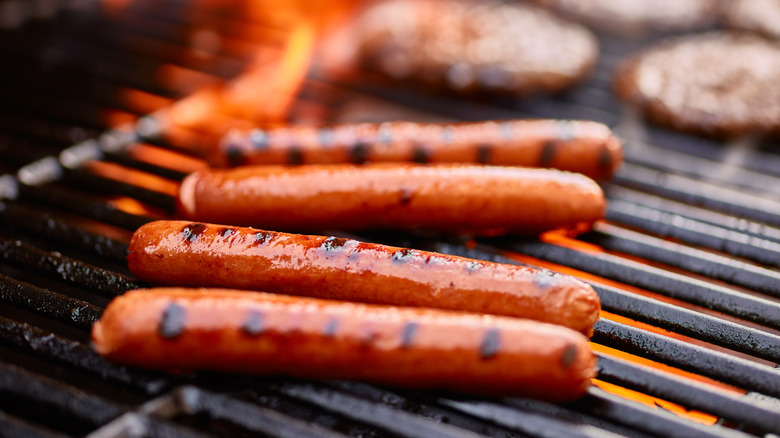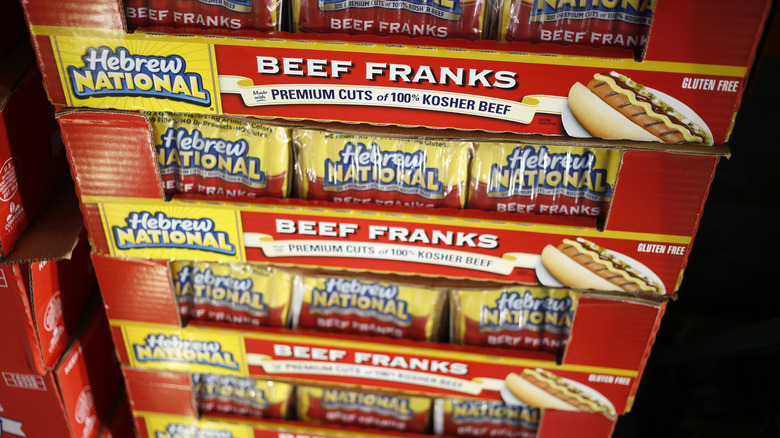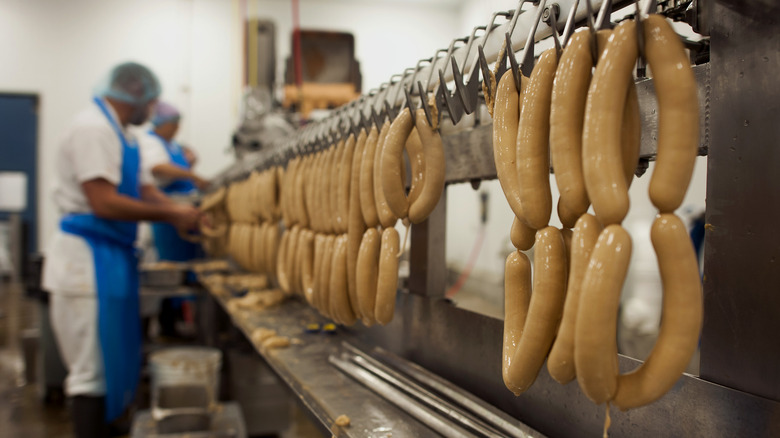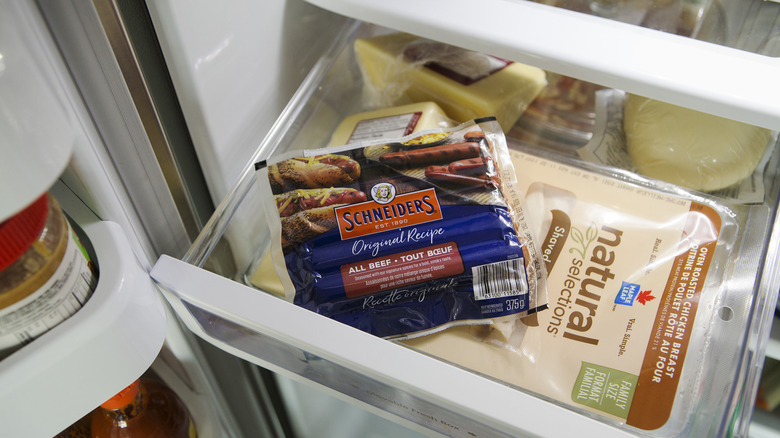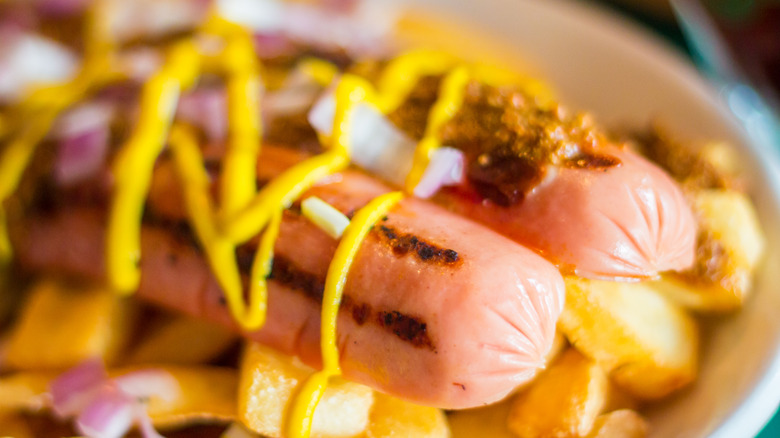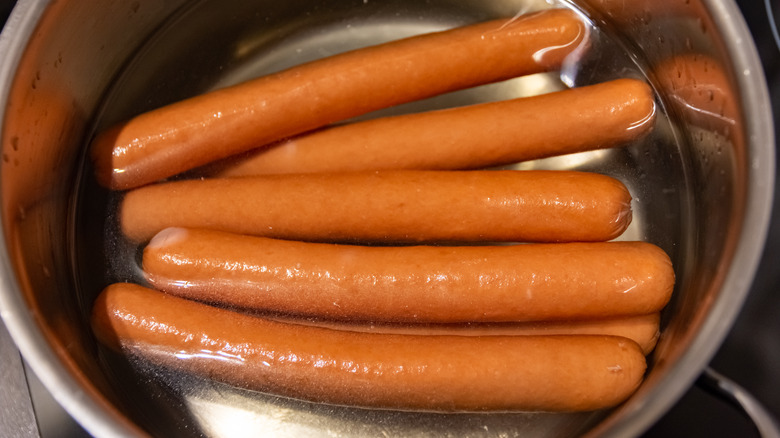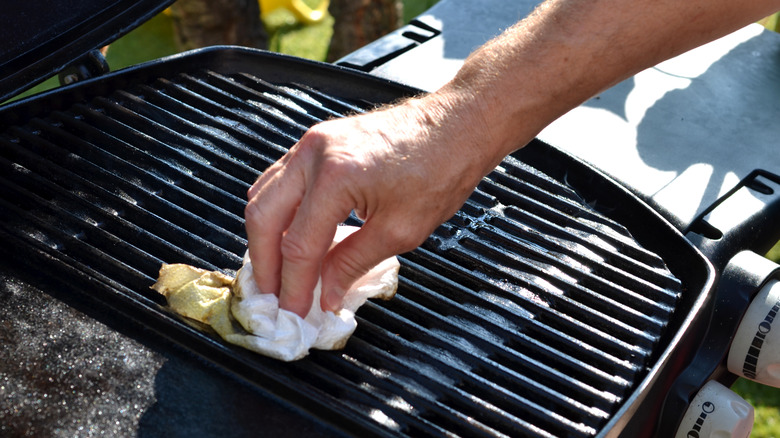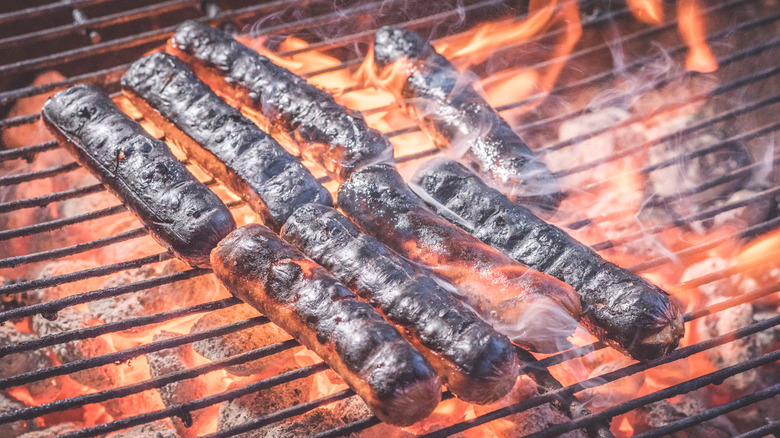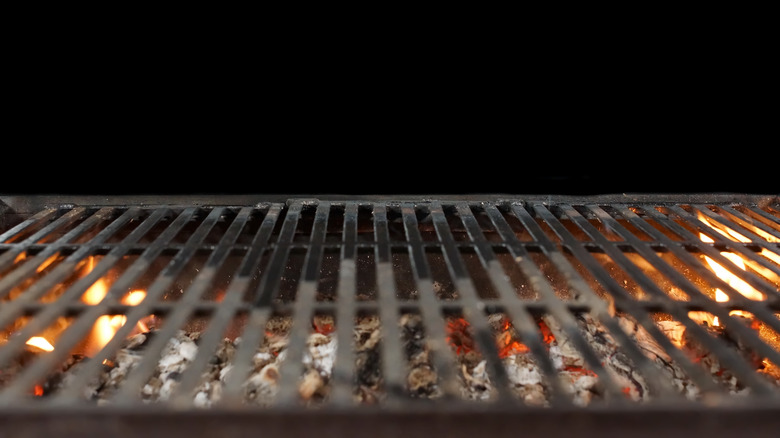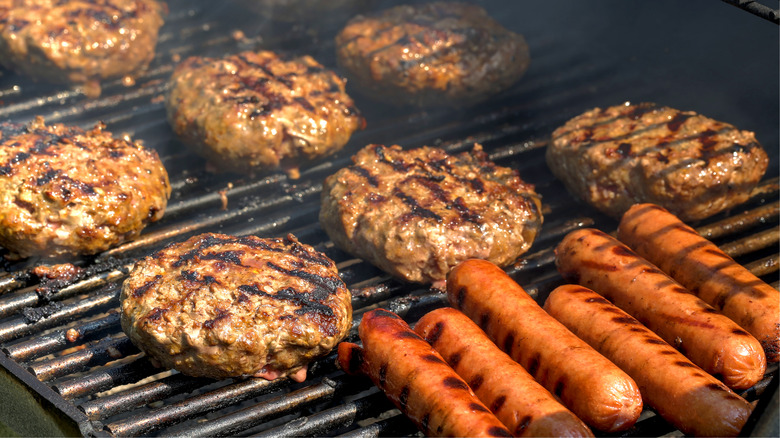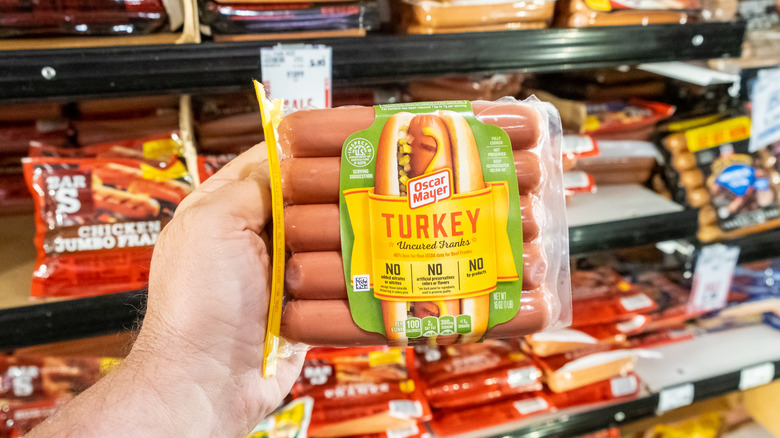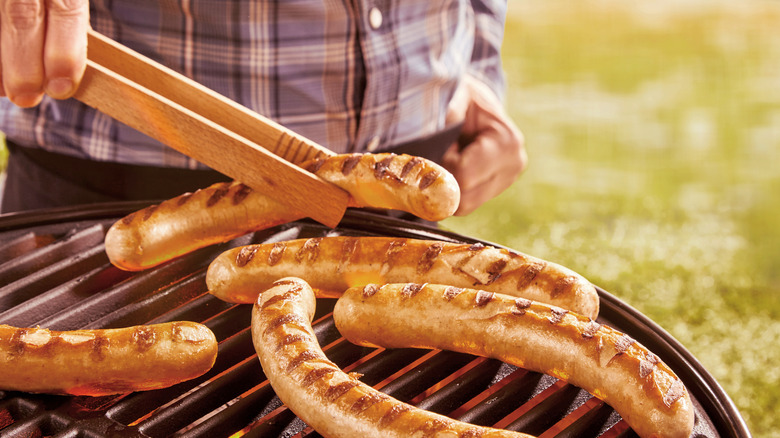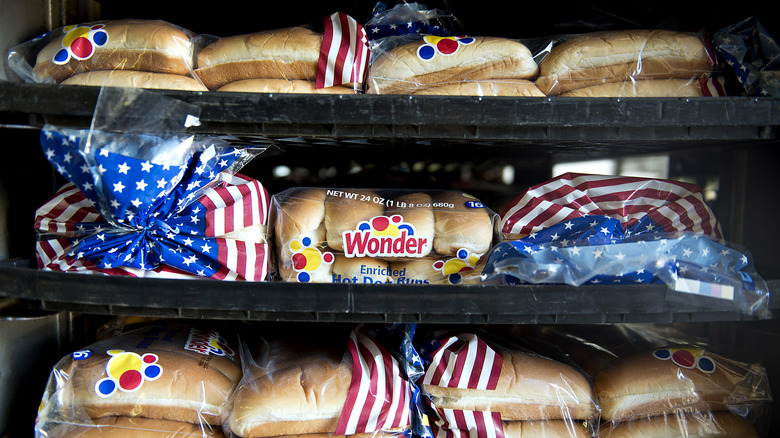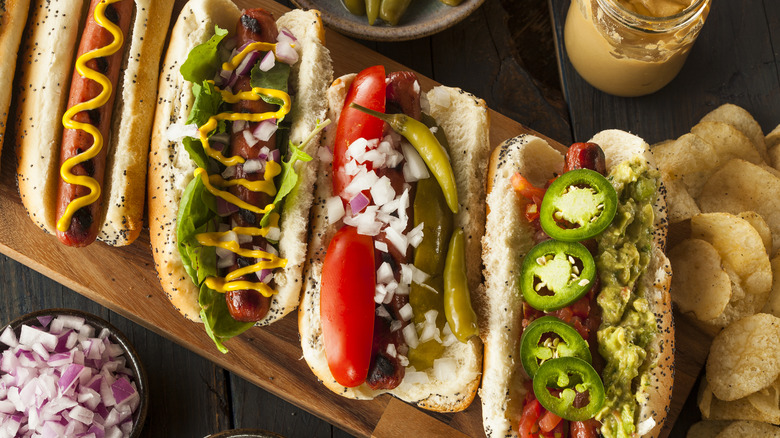Mistakes People Make When Grilling Hot Dogs
Everyone loves a freshly grilled hot dog ... right? Okay, maybe not everyone's experience with grilled hot dogs is the same. After all, when you get a grilled hot dog done right, it tastes pretty amazing — like childhood summers, baseball, and backyard parties filled with family and friends. When you get a grilled hot dog that's less than that, it's basically just a meat stick of disappointment and dread. There's so much that can go wrong. Maybe the hot dog tastes like mystery meat. Maybe it's burnt to a char. Maybe it's not cooked well at all. Maybe it's about as plain as that bun. But that's just because there are so many simple mistakes people can make when grilling their hot dogs, from not purchasing the right hot dogs in the first place to not prepping the grill correctly to not really paying attention to the cooking process.
If you want to recreate those perfect grilled hot dogs of your dreams, the ones that take you back to those perfect childhood summers, you're going to want to take a look at our list of the top mistakes people make when grilling hot dogs — and then do everything in your power to avoid them.
Not buying the right hot dogs
First up, if you're not buying the right kinds of hot dogs, you're just not going to have a stellar experience. Yes, it's tempting to buy the budget-brand hot dogs that are on sale, but you'll regret it. Trust us. You'll always regret it.
The bare minimum measure of quality when it comes to hot dogs? An all-beef center. If the packaging says that the hot dog is made up of some strange mixture of chicken, beef, and pork, you probably ought to stay away. After all, you don't really want to mix up all of those proteins in any other dish you make, so why would you want to do that for your hot dog?
Another sign of sure quality? If the hot dog has a natural casing made from pork or lamb, you're likely in good hands. You want something that's going to snap when you bite into it. When a hot dog snaps, that means it's fresh.
Not paying attention to your hot dogs' "skin"
Along these lines, you want to pay attention to what your hot dogs' packaging says about its casings, or "skin." Natural pork and lamb casings are the most desirable, as they not only provide that snap, but they also hold in all of the hot dogs' natural juices. But don't be fooled if you see a hot dog that claims it's made with a cellulose casing, because that's not a real casing at all, and you don't want it. What's the difference?
In the instance of a natural casing, the casing is retained through cooking and then when eating. If a hot dog uses a cellulose casing, though, that means the maker simply fills the casing with their hot dog meat, smokes it, and then peels the casing off before packaging and selling the hot dog. That means the hot dog doesn't come with an intact casing and it is, essentially, "skinless." That means no snap and nothing to hold in those juices. So, when you're shopping for some hot dogs, look for the natural casings only.
Freezing your hot dogs ahead of time
According to the USDA, hot dogs last about two weeks in the fridge, unopened. Then, after opening, they last a week. However, if you pop those pups in the freezer, they'll last one to two months at top quality and indefinitely at subpar quality. But just because you can do something doesn't mean you should.
The problem isn't with the freezing itself, though — it's in the defrosting. According to TODAY's experts, if you don't thoroughly ensure that your dogs have completely come up to room temperature all the way through, they just won't cook evenly, and you'll have a difficult time. You might even find that your hot dog is burnt to a crisp on the outside before it even becomes remotely warm on the inside. Ew.
So, to play it safe, don't freeze your hot dogs. Just purchase the hot dogs within two weeks of when you plan to eat them.
Poking or splitting (or not poking or splitting) the hot dogs
Okay, so this one is a bit of a contentious issue. You have scores of people who swear by butterflying their hot dogs, so why would I tell you to never poke or split your hot dogs? It all comes down to the type of hot dog you purchase. If you take the above advice and only buy hot dogs that feature a natural pork or lamb casing, you won't want to poke or split your hot dog because you'll damage the casing and then you'll no longer get that great snap and you release all the tasty juices into the bottom of your grill.
However, if you don't care for natural casings and you only eat hot dogs made with cellulose casings, then, yes, you can butterfly, poke, split, or treat your hot dogs however because you won't be losing anything in the process. According to one Serious Eats food writer, that's really the only way to eat cellulose-cased hot dogs: "To prevent ... unsightly and undesirable shriveled hot dogs, I've been slashing skinless franks for years ... Skinless hot dogs cooked this way stay plumper and juicier and don't suffer the same shriveling of the skin."
Not soaking your hot dogs ahead of grilling
If the last thing you want is a hot dog that's dry and lacking in flavor, soaking your hot dogs ahead of grilling them could be exactly the new step to add to your normal hot dog-cooking process. While it's not 100% necessary, it is a quick and easy way to add an extra hit of flavor and moisture to any hot dog.
There are a few ways you can go about this. Traeger Grills recommends "bathing" your hot dogs in a simmering ale or other flavorful liquid of your choice for a few minutes before you grill them, so long as you're careful not to simmer the hot dogs so much that you actually cook them.
One Epicurous writer takes a similar approach by partially poaching their hot dogs before grilling. Their process is simply to heat a saucepan of water to about 150 degrees Fahrenheit, then turn the heat way down and add the hot dogs, letting them sit in the hot bath for about 10 minutes. From there, you can go on to grill your hot dogs without worrying about getting them to just the right temperature in the middle or cooking them so long that they end up a dry, shriveled mess.
Not cleaning and oiling up the grill ahead of time
Once you're ready to start cooking those hot dogs, you need to take a look at your grill. Just like you wouldn't cook with a grime-encrusted, dirty pan in your kitchen, you don't want to cook on a grime-encrusted, dirty grill in your backyard. So, give it a clean with a grill brush, first and foremost. Then, you want to oil up your grill ahead of turning on the heat. This is vital to your hot dog-cooking experience, because if you skip this step, you're very likely to end up with hot dogs that simply won't rotate easily or that altogether stick to your grates. And no one wants to spend their grill session ripping hot dogs off a grate. For oil, you can either spray your grill grates with a non-stick spray from the kitchen or use a paper towel with a bit of high-heat oil (like peanut oil) and manually wipe down the grates.
Leaving the grill
It's happened to us all before. You start up the grill and really get it going, you throw on some hot dogs, and then the distraction happens. Whether it's your thirst for another frosty beer from the fridge, a friend or family member who's just arrived at the barbecue, or shooing a hungry pup from beneath your feet, whatever that distraction is, it effectively gets you away from the grill. Then when you return, your hot dogs are worse for wear. You might not even notice it at first — but once you start really paying attention to how your hot dogs turn out, you'll definitely realize that the more attention and love you give them, the better they'll be.
That's because hot dogs take very little time to cook — and if you're cooking grass-fed beef hot dogs, they'll take even less time to cook. According to a Men's Health article, your average hot dog only takes about two to three minutes to char on each side, which means your hot dog will cook in six minutes or less. If you're cooking grass-fed beef hot dogs, they'll take about one minute per side, or two minutes total, due to the lower fat content. In other words, walking away for even a few seconds could spell disaster (and dryness) for your hot dogs.
Letting the casing burst
We've already talked about how a high-quality hot dog is apt to have that tasty all-natural casing that just snaps when you bite into it, releasing all of those tasty spices and juices, but what if your hot dog snaps prematurely? That's exactly what can happen if you put the hot dogs over too high a heat, allowing the casing to burst and leaving you with a hot dog that's less than ideal.
According to the Hofmann Sausage Company, which has been making German-style hot dogs since the late 1800s, high grill flames are your enemy when it comes to cooking hot dogs. The company, which is based out of Syracuse, New York, told Syracuse.com, "The trick is to not put the hot dogs over a high flame, otherwise they're apt to split and burst open and leak juices and fat, which can lead to flare-ups."
Cooking your hot dogs on too low a heat
But on the other side of things, while you don't want to cook your hot dogs over high heat, due to the risk of your hot dogs bursting open, you also don't want to cook your hot dogs over too low a grill heat. If you start your grill and don't allow it to heat up and just toss your hot dogs right on, you could end up with a tough, dry hot dog that's just been sitting over low heat for too long. The same thing could happen if you let your grill die down too much before adding your hot dogs. The key is striking just the right balance. According to the experts interviewed at Business Insider, the ideal grill temperature for cooking hot dogs is about 425 degrees Fahrenheit.
Not sure how to check your grill's temperature? Use the hand test. If you can hold your palm roughly three inches above the grill gate and hold it there for four seconds before pulling it away, your grill is somewhere between 400 and 450 degrees Fahrenheit.
Putting your hot dogs over direct heat
I know what you're thinking — even more rules about hot dogs and heat? Well, it turns out that incorrect heat, whether it's too low or too high, can really ruin your hot dog experience. Additionally, according to TODAY's "meat experts," you shouldn't cook your hot dogs over direct heat, either. Avoid direct sources of heat and open flames, regardless of whether you're cooking with charcoal or gas. And, if you are cooking with charcoal, the experts recommend, wait until the coals are completely white before you add any of your food, hot dogs included, to your grill. This will ensure your temperature isn't too high.
Charcoal brand Kingsford further recommends that, when cooking hot dogs over charcoal, only stack your charcoal on one side of your grill, so you can move your hot dogs around the grate if you find that the heat is too low or high in one spot after you start cooking.
Grilling all your hot dogs on the same heat
Okay, this is the last heat-related mistake people commonly make when grilling hot dogs: It's grilling all of their hot dogs on the same heat. Not all hot dogs should be grilled at the same temperature, just like, as mentioned above, not all hot dogs can be grilled for the same amount of time, due to varying fat content.
Grilling expert and condiment creator Julie Busha told Business Insider that grill masters at home should "consider the fat content in the hot dogs to determine what heat you should be grilling at. Higher-fat dogs should be cooked at a medium heat whereas leaner dogs should be grilling on a medium-low setting." Look at your hot dogs' fat content before you plop them on the grill, and if you know you specifically bought low-fat hot dogs, like some of the fat-free options on the market, or even turkey or chicken hot dogs, turn down that flame.
Not rotating your hot dogs
Once you get your hot dogs on the grill and you're confident that you have the best heat level for your particular hot dogs, you can't just walk away. You have to rotate those dogs. Based on the fat content of your hot dogs, you'll want to rotate them every minute or every few minutes. You'll get a feel for how often you need to rotate by how quickly the hot dog casings develop grill marks. It's better to err on the side of rotating too quickly than it is to err on the side of rotating too slowly.
And once you have grill marks all the way around, you're not done. As Good Housekeeping points out, you want to roll those dogs all the way to the coolest side of your grill (or, as Kraft Heinz recommends, move them to your grill's upper rack, if it has one) so that you can use your gas or charcoal heat for the next step in the necessary process for grilling a perfect hot dog.
Not grilling your bun too
And that next step in the process? Grilling your bun, of course! Why would you put all this effort into lovingly creating a deliciously cooked, ideal hot dog, only to put it in a cold, tough, lackluster bun? Regardless of what kind of hot dog buns you buy, you can upgrade them with a little time on the grill. Just use the same heat you were using for your hot dogs, and once the dogs are done, toast up your buns for a minute or two.
An NYC hot dog expert told NPR that adding a little bit of butter to the bun ahead of grilling helps, too: "Mom's grilled-cheese sandwich when you were a kid was always kind of made in a frying pan with butter — and was always delicious. Anything with butter on it is great. I'm not saying it's good for you, but ..."
And if you're just plain bored with your average hot dog bun? Nathan's Famous has a few ideas for you to shake things up a little by adding your grilled dog to a baguette, pretzel bun, or even a tortilla.
Not paying attention to your condiments
Oh, you thought once your hot dog was done and your bun was toasted that you were finished creating the perfect hot dog? Not so fast! You're going to want to pay close attention to your condiments, too. While you could go with plain mustard and ketchup, if you really want to take your grilled hot dogs to the next level, you're going to want to get creative with your toppings.
Don't be scared! Your hot dogs are a blank canvas on which you can paint an endless array of gourmet flavors. And if you're not exactly sure where to start, just check out these ideas from Food Network Magazine, or try some of Oscar Mayer's out-of-the-box recommendations, like mango salsa or melted cheese. From diced tomatoes to basil, plum sauce to jalapenos, if you like it, chances are it'll probably taste pretty good on a hot dog.
